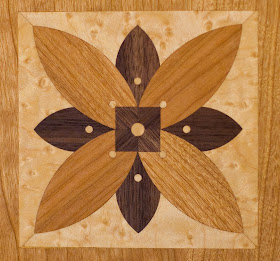One way the church has (especially recently) helped temples feel unique and built for a given state or nation is to use locally significant flowers. Many of the first types of small temples included the state flower in carpets, upholstery, and elsewhere. This was one of a few changes to help these nearly indistinguishable temples fit in locally. With other temples the local changes were far more involved and now great effort is made to have temples of the same plan be vastly different.
The Holy Ghost Lily, the national flower of Panama, is used in the Panama City Panama Temple. This flower is prominently displayed throughout the temple. The nice thing about this flower is that it is also symbolic. It gets its name because it looks like there is a dove in the center.
 |
| Holy Ghost Lily, Panama City Temple Inlay |
 |
| Syringa Flower, Twin Falls Idaho Temple Railing |
 |
| Syringa Flower, Twin Falls Idaho Temple Wood Inlay |
 |
| Draper Temple Sego Lily Details |
The Winter Quarters Nebraska Temple has the state flowers of the five states the pioneers passed through. The Church News said:
Throughout the temple on art-glass windows are represented the state flowers of the five states through which pioneers trekked — Illinois, Iowa, Nebraska, Wyoming and Utah. In the Celestial Room is the sego lily, designated as the state flower of Utah because its roots provided sustenance for the Pioneers during their first winter. It was as manna from heaven for them, Brother Holdman noted. Thus the presence of the flower in the celestial room represents the completion of their journey to the promised land and alludes to Revelation 2:7,17, "To him that overcometh will I give to eat of the tree of life which is in the midst of the paradise of God. . . . To him that overcometh will I give to eat of the hidden manna."So not only do the flowers make the temple unique, but they also make it symbolic. The state flowers are the Blue Violet (Illinois), Wild Rose (Iowa), Goldenrod (Nebraska), Indian Paintbrush (Wyoming), and the Sego Lily (Utah). The temple also has thistles in a design in the upstairs waiting area. Thistles are prickly and may be a symbol of trials. Their use may be more positive as thistles are hardy and a royal flower (United Kingdom coins have a thistle with a crown representing Scotland). The thistle was also another plant that the pioneers ate to keep from starving.
The new Kyiv Ukraine Temple uses Ukraine's national flower, the sunflower, throughout the temple. The flower is found in decorative painting and in fabrics. See this church newroom article.
The newly remodeled Laie Hawaii Temple now has the Hawaii state flower. This Deseret News article states:
Elder Scott Whiting, an area Seventy and coordinator of the local temple committee, said during the renovation the temple has been structurally hardened and will stand well into the future. "The original beauty and structure of the temple have remained intact during the renovation process," he said. In addition, he added, the state flower, the hibiscus, and leaves and nuts from the kukui tree add local significance to the temple's décor.
 |
| Laie Hawaii Temple Recommend Desk Glass Detail |
I really like that some effort is made to give temples a local touch. I have no problem with imported materials, but I also like to see something local represented. I also like it when the flowers have some added symbolism as most of those listed above do.
Please comment and let us know what you think about using local flowers in temple designs.
I appreciate the Church's effort to include locally resonant motifs in the details. (Another example is the Statue of Liberty torch motif incorporated into the hardware of the Manhattan Temple.)
ReplyDeleteI think that efforts to relate the overall design to the architectural heritage of the region are even better. But the Church doesn't do that very often, because temples aren't really meant to blend in.
Examples include the mission architecture of the Newport Beach Temple, the (aforementioned) Mayan influence in the Mexico City Temple, and the Asian influence in the Oakland Temple (note the corners of the towers). In the latter case, it was intended to acknowledge the Bay Area's Asian membership——Hmong and Laotian congregations particularly. Nowadays, those congregations have shrunk, and the area's Hispanic and Polynesian membership is much larger.
I also appreciate the effort the Church has made with Temples to anchor them to the country they are in. In some of the New Zealand Temple sealing rooms there are on the ceiling the national symbol of the fern in gold. Also originally one of the chandeliers resembled a flax plant...significant to the indigenous Maori as they harvested the plant for many uses, therefore it was a great symbol of how the Temple of God sustains and nourishes his people.
ReplyDelete